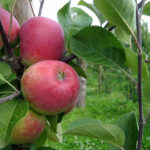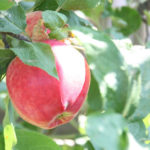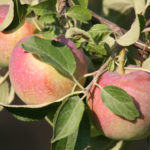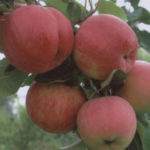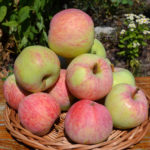Cherry variety Ashinskaya
In nature, spontaneous cross-pollination of different varieties of one crop often occurs, as a result of which a new variety appears. The main thing is to notice its qualities in time. This happened with the Ashinskaya variety, which appeared due to an unexpected crossing between the steppe cherry and the ordinary one. It happened in 1992 on the basis of the South Ural Research Institute of Horticulture and Potato Growing. Scientists worked on improving the selected hybrid - A.E. Pankratova, K.K. Mullayanov, V.I. Putyatin and I.G. Zamyatin. Our hero got into the State Register of Breeding Achievements of the Russian Federation in 2002. The admission region is the Ural (Republic of Bashkortostan, Chelyabinsk, Kurgan, Orenburg regions).
Description
The tree is fast-growing, but not tall, as befits the carriers of the steppe cherry genes, it looks beautiful, slender, 2.5 - 3 meters high. The stem is 25 - 40 cm. The crown of Ashinskaya is elongated-conical, compressed, well leafy, not too thick, but prone to thickening. The shoot is rounded, the bark is ash-brown, with a slight silvery effect, without pubescence, 30 - 40 cm long. On the surface there are medium-sized lenticels in small numbers. The leaves of the variety are oblong, narrow-oval, short-pointed, with a sharp base and a double-clawed edge. The leaf plate is curved upward along the central vein. The surface is smooth, without pubescence, glossy, with clearly visible veins, dark green in color. There are traces of anthocyanin coloration at the base of the leaf. The glands are small, yellow, rounded. The standard size of Ashinskaya's leaf plate is 7 cm long, 3.5 cm wide. The petiole is of medium thickness, short, there are no stipules. The kidneys are of normal size, elongated, with a smooth surface, bent. Large cherry inflorescences consist of 5 flowers on short stalks. The flowers are fragrant, small, with widely-oval, free-ranging petals forming a saucer-shaped corolla. The top of the petal is bifurcated, not crimped. The calyx of the flower is bell-shaped with weak serration. The number of filaments is 26, the stigma is located below the stamens, the ovary is without pubescence. The type of flowering and fruiting of the variety is mixed. The ovary is mainly formed on one-year increments - up to 70%, the remaining 30% falls on bouquet twigs of two-three-year-old wood.
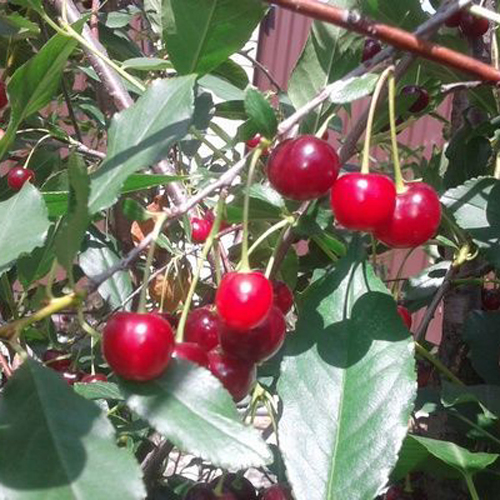
Assessment of the appearance of Ashinskaya berries - 4.7 points. The shape is rounded-oval, with a rounded apex, a narrow funnel, a groove around the fruit and an abdominal side sloping towards the apex. The abdominal suture is poorly expressed. Berry weight 4.5 grams. The skin is thin, glossy, dark brown. The pulp is medium density, dark red, juicy. The juice is red. Cherry has a sweet and sour taste, pleasant. Assessment of tasters - 4.4 points. The peduncle is long - 3.5 cm, straight, thin, obliquely set. The separation from the berries is easy, dry. 100 grams of pulp contains: dry matter 16.3%, sugars 11.7%, free acids 1.8%, ascorbic acid 10.3 mg%.
The round bone is relatively small - 0.17 - 0.20 grams, which is 8.1 - 10% of the total weight of the fruit. The dorsal suture is moderately smoothed, the abdominal suture is medium, the ribs are smoothed. Length - 0.6 mm, width - 0.5 mm, thickness - 0.4 mm. Light cream color.
Characteristics
- During the fruiting period, the cherry enters quite quickly - for 4 years;
- flowering occurs on average - May 23 - 30;
- in terms of ripening, Ashinskaya belongs to the late summer varieties - the fruits ripen from July 20 to August 3, depending on the climate;
- berries ripen almost simultaneously;
- plant life span - 30 years;
- the standard yield indicator is 75 kg / ha. Fruiting is stable, annual;
- berries are highly marketable, resistant to cracking;
- general frost resistance is satisfactory, generative buds have average frost resistance, flowers resistance to spring frosts is above average;
- cherry has a high ability to recover from freezing;
- drought resistance of the variety is high;
- immunity is good - there is a high resistance to coccomycosis. No other diseases and pests were found;
- it is easy to propagate a culture, resorting to all possible methods - using a cuttings, grafting, sowing seeds, etc.;
- the application is universal, although berries are often used as a dessert. Jams, compotes, juices turn out to be unusually tasty.
Pollinators
Ashinskaya is considered partially self-fertile. Even a singly planted tree will be able to yield crops, but in this case it will not fully reveal its qualities. Therefore, in a pair with it, it is still worth picking up a pollinator that blooms at the same time as the described variety - Nochka cherry, Ruby or Altai swallow. By the way, it is worth noting that our heroine herself is an excellent pollinator.
Planting and leaving
In the growing region, the variety is best planted in the spring, before the sap begins to flow. By the autumn cold snap, the plant will have enough time to build up the root system. The only drawback of a spring planting is the frequent watering, which will have to provide the seedling. But in the future, you will have to water only as needed. Since the variety is prone to thickening of the crown, pruning will be a necessary point of care.
Ashinskaya is absolutely undemanding to soil. With proper care, it can grow even on rocky ground, but the site should be sunny. Good development and an abundance of fruits will provide top dressing. They can be mineral (cherries like superphosphate fertilizers, but it is advisable to apply them in the fall) or organic. In dry weather, it is imperative to water the tree after flowering and during the growth of the fruit. Preventive treatments for diseases and pests are carried out as needed.
Ashinskaya is a variety that is unusually resistant to many common diseases and pests, is unpretentious in care and brings decent harvests annually. Excellent taste and marketability of berries make the variety popular among consumers. And on the basis of its characteristics, it is suitable for growing in collective and industrial gardens.
The only drawback is not quite high frost resistance. Freezing up to 3 points causes a decrease in winter temperatures to -48 ° C and below. But this disadvantage is compensated by the high regenerative ability of cherries.
